ROCK inhibitor Y-27632 attenuated early endothelial dysfunction caused by occupational environmental concentrations of carbon black nanoparticles†
Abstract
The unique properties of carbon black nanoparticles (CBNs) make them feasible for new applications and raise concerns about cardiovascular disorders. Exposure to CBNs has been associated with the progression of atherosclerosis, whereas little is known about the mechanism. Here, we used CBNs to investigate whether the RhoA/Rho-associated coiled-coil containing protein kinase (ROCK) pathway is required to elevate the risk of developing endothelial dysfunction under realistic occupational environmental concentrations. The effect of a specific inhibitor of ROCK, Y-27632, on CBN-induced endothelial dysfunction was evaluated using endothelial monoculture and co-culture models. We evaluated the endothelial barrier integrity by measuring endothelial cell migration, transendothelial electrical resistance, tight-junction proteins, and cytoskeletal rearrangement. CBNs significantly induced endothelial barrier dysfunction, which was attenuated by Y-27632. Furthermore, upregulation of monocyte adhesion and migration was attenuated by Y-27632 in a co-culture model of monocytes, macrophages, and endothelial cells. Finally, a change in oxidized low-density lipoprotein and endothelial nitric oxide synthase, which contributes to the development of atherosclerosis, was also inhibited by Y-27632. Our results indicate that the RhoA/ROCK signaling pathway may upregulate inflammatory stress and mediate the development of early endothelial dysfunction induced by realistic occupational environmental concentrations of CBNs. Pharmacological inhibition of ROCK may have therapeutic potential in preventing CBN-associated endothelial dysfunction.



 Please wait while we load your content...
Please wait while we load your content...